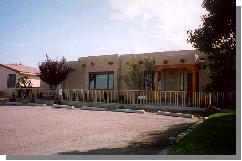NM APARTMENT
1 9 8 9
REPORT
1 9 9 8

"Manufactured Housing - Public Enemy #1"
Originally appeared inNew Mexico Apartment Report Vol. 4.2 - Q2’97
As mobile homes grew in popularity, something had to give.
The burgeoning popularity of manufactured housing, once the black sheep of the housing industry, has taken a bite out of the apartment market, according to a top apartment real estate broker in Albuquerque.
“We created this scenario,” Todd Clarke of Grubb & Ellis/Lewinger Hamilton Inc. said. “Affordable housing has left our market. Single-family and multi-family housing have gone beyond the means of a majority of the population. Manufactured housing has filled the void.”
The impact on the apartment market has been a steady drop in the occupancy rate in the Albuquerque metropolitan area over the past two years. At the same time, the sale of manufactured housing has seen double-digit increases.
“A combination of several forces have driven this,” said Clarke, ranging from politics through financing to changes within the manufactured housing industry.
Mobile homes became the black sheep of housing in Albuquerque during the 1970s, he said, with officials establishing a trend still strong today of rejecting permit requests for mobile home parks. During the 1980s, Clarke said the metro area averaged about 300 mobile homes a year.
While the mobile home market languished, however, the apartment scene saw a building explosion from 1984 to 1987. Permits were issued for 12,000 new units, which Clarke said represented a more than 30 percent increase in the metro area’s inventory of 35,000 units at the time.
Apartment occupancy subsequently plummeted, hitting a low of 83.5 percent in 1986. “Banks stopped making loans for multi-family housing,” Clarke said. “It was much easier to get financing for a 20-home subdivision than a 100-unit apartment.”
Overall residential construction went into a slump in the late 1980s, Clarke said, with the single-family housing vaulting out of it in 1992 with a 40 percent jump in permits to over 3,200. That same year, only 48 apartments units were built in the metro area.
By the same token, the average apartment occupancy rate had increased steadily from the 1986 nadir and, by 1993, was over 98 percent. Rents were going up between 10 percent to 25 percent a year, Clarke said.
“Because we weren’t building apartments at a reasonable rate, rents went through the roof,” he said. “They’re now getting pretty high for the average wage earner.”
Simultaneously in the early 1990s, the manufactured housing industry began offering higher quality homes at still affordable prices. “It was a movement toward what the buyers wanted,” Clarke said. “The companies producing them doubled or even tripled their market.”
Manufactured housing accounted for 34.5 percent of all new housing in New Mexico in 1993, according to statistics, with its share growing to about 45 percent of all new housing in 1996.
There were 7,301 mobile homes sold in New Mexico in 1995 and 8,250 sold in 1996. Clarke estimates that as many as 3,000 of the mobile homes sold in each of those years were placed in the greater Albuquerque area. He added that the state’s first manufactured housing plant – Cavco Industries of New Mexico in Belen – is capable of making 10 mobile homes a day.
Clarke said factors motivating apartment tenants to make the transition to manufacturing housing is its affordability (monthly payments typically run less than apartment rent), the satisfaction of home ownership and the fact there are no apartment rules like no pets or hanging laundry outside.
In addition, there’s no investment incentive to rent. There is, however, for manufactured houses if they’re classified as real estate.
“You can build equity,” Clarke said. “You may not get as much as with a regular house, but you have none in an apartment.”
He said he was surprised at how quickly manufactured housing filled the growing void of affordable housing for many Albuquerque residents. “They did it faster than multi-family housing ever could.”
The problem with multi-family housing resembles what happened to mobile homes 20 years ago: It’s not wanted. Clarke said it’s extremely rare for city property to be zoned for apartments these days and, even if with proper zoning, it “takes so long to get an apartment development through the city (approval process) and past the neighborhood associations.”
The metro had a mini-boom in apartment construction from 1994 to 1996, when permits were issued for 4,600 units. Clarke disagrees with the prevailing opinion that it was construction of these units that has led to the drop in occupancy rate.
“I hear over and over, particularly when I talk to property managers, that we built all of these new units and did it to ourselves,” he said. “Really, had we not had manufactured housing we would have absorbed those units.”
Clarke said those 4,600 units represented just over 6 percent of the metro area’s current inventory of 68,000 apartment units. That small of a percentage increase in inventory, after a five-year lull in construction should only have produced a blip on the screen.
Article by
by Todd Clarke CCIM (www.nmcomreal.com/nmcomreal)
p a g e
o n e
